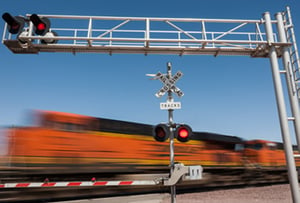stop. trains can't.
We all need to take greater care at highway-rail grade crossings. A highway-rail grade crossing is an intersection where a roadway crosses railroad tracks at the same level or grade. Such crossings may be encountered on both public and private roads. There are more than 250,000 such crossings in the U.S. Although the highway safety picture has improved considerably over the last decade, still too many people are killed and injured every year at grade crossings. Of all the highway-rail grade crossing incidents annually, around 500 involve trucks or tractor-trailers. This translates to an average of about 10 per week.
Last year alone, 270 people were killed at railroad crossings. Of those, 99 people died after the driver went around lowered crossing gate arms – a 10-year high. And many of these fatalities at highway-railway crossings are preventable. Every four hours in America, a person or vehicle is struck by a train at a rail crossing. Over the past five years, 798 people have died while trying to drive across railroad tracks.
As a result, the Department of Transportation last month initiated a public service campaign, “Stop. Trains Can’t” to remind drivers about the potential risks of an approaching train when crossing railroad tracks, especially when active warning devices such as flashing lights or gate arms are descending or lowered.
Given their size and weight, neither freight nor passenger trains can stop easily to avoid cars or other vehicles on the tracks. Trains cannot swerve out of the way, and a freight train traveling 55 mph can take more than a mile to stop, even when emergency brakes are applied.
Here are some rules to follow when approaching highway-rail grade crossings:
- Approach with care. Warn others that you are slowing down. Turn on 4-way flashers. Use pull-out lane if available.
- Prepare to stop. Turn off fans and radio and roll down windows. Locate your cell phone for use in an emergency. Stop at least 15 feet, but not more than 50 feet, from nearest rail.
- Look and listen both ways, carefully. Bend forward to see around mirrors and A-pillars.
- If it won’t fit, don’t commit. Do not enter a crossing unless you can drive completely through without stopping! And, remember, trains are wider than the track. Before you pull onto the track, make sure there is enough room on the other side for the back of your vehicle (and any overhanging cargo) to be at least 3 feet beyond the furthest rail.
- Look again. Before you move, look again in both directions.
- Cross tracks with care. Signal, watch for a safe gap, pull back onto the road if you used a pull-out lane. Use highest gear that will let you cross without shifting.
- Keep going once you start, even if lights start to flash or gates come down.
If you are operating a vehicle with a long wheelbase, a low ground clearance, or that requires a special weights and dimensions permit, it is especially important that you and your motor carrier take special precautions to ensure that your rig and its cargo can safely traverse highway-rail grade crossings.
The June 2019 Driver Safety Letter has been provided and co-sponsored by NPTC and CPC Logistics . This month’s letter, “Stop. Trains Can’t,” includes safety tips when approaching highway-rail grade crossings.
The Monthly Driver Safety letter is a Microsoft Word document that you can print out and post as is, if appropriate, or modify any way you wish to make it a better fit for your drivers, including adding your company logo. If you are already doing an in-house letter, you may find information here that you can cut and paste into your own letter. If you are interested in specific subjects, or have any comments/feedback, contact Tom Moore, CTP, at tmoore@nptc.org.









